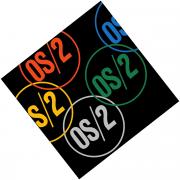The Hitchhiker's Guide To OS/2 - Issue 4

The Hitchhikers Guide To OS/2
- About The Guide
- Here and Now
- SoftViews
- TechnoWatch
- OS/2 Tips
- Trivia Question
- DESKTOP CONTEST!!!
- How to Submit An Article
About The Guide
The Hitchhikers Guide To OS/2
Issue #4
Published On 4/9/94
This guide is meant to give a concise report on current OS/2 events. Any and all contents are solely my opinion. If you don't agree with them run around the net and delete every copy you can find. Otherwise sue me, but all I have is a 2400 baud modem and a bunch of credit card bills. Anyone is welcome to the latter :). Read on and I hope you enjoy another issue of the HitchHiker's Guide To OS/2.
Any Comments Regarding The Guide or monetary donations can be directed to:
sdudas@austin.onu.edu
Steve Dudas.
Special Thanks go to Dr. V. Phaniraj for letting me know that wp2ipf/2 exists.
In you haven't guessed that is what this is done with.
Thanks to Kim Kruse Hansen for the great job he has done with this application.
Copies of the HHGOS2 will be available for anonymous ftp from ftp-os2.cdrom.com.
look in /pub/incoming/hhgos2_#.zip
every other Saturday for a new release or look in /pub/os2/2_x/info/newsltr/hhgos2_#.zip For back issues.
The .zip file will contain both a .txt and the .inf version of the HHGOS2.
Here and Now
SOM for Windows.
IBM has announced plans for a Windows 3.1 upgrade package which will give windows users access to many of the object oriented features we enjoy using OS/2. This package will patch 3 windows files and provides drag and drop, notebook type settings, along with a host of other PM features. The package is apparently scheduled for release sometime this summer.
Et4000 W32i
A new release of the Et4000 W32i drivers has been released. The file name is os2w32.zip and is available on ftp.cdrom.com. I recently purchased a Et4000 w32i and fell in love with it. It has the raw power to make the video fly for a minimum amount of money. I paid $179 for a 2 meg version.
The card came with version 1.0 drivers. The latest ones in cdrom are v1.02 and haven't changed that much. The biggest improvement is in the installation. It has been greatly simplified to running a REXX command file and following instructions. The main drawback to all of these drivers is that they are all built for cards with 1 meg of ram. Thus they only run up to 256 colors. I have to assume that will be corrected since the 2 meg cards are so cheap.
SoftViews
This issues review goes to Povframe 2.0.
This application provides a PM front for the ever popular raytracer Povray, and was built by Bill Pulver. Povframe, while a bit slow, provides and excellent interface into the povray program. The interface allows the user easy access to every important setting. From image buffer sizes to the height and width of the trace. It then instructs a text based version of Povray which was compiled using Cset++.
Povframe also allows you to specify a viewer that can be used to view the picture as it is raytraced. Povframe also has a whole range of options to create a animation file. I have not had time to play with this but it could be very interesting.
Povframe also makes it very easy to edit scene files by providing an edit choice which brings up the selected file in a OS/2 PM editor window. Altogether its a very well thought out product, and very easy to use.
TechnoWatch
One hot topic seems to be the future of OS/2. Here I will try to give a synopsis of what is currently planned / known / under consideration. Since this article may be considered a "vapor" article I would like to remind all that much of this is purely my opinion.
It appears that within one year OS/2 is going to undergo its greatest test. Chicago should be on the scene, and unless OS/2 2.2 is incredible and or Chicago is horrible, OS/2 in its current form will be relegated to a few diehard users. We must face the fact that MS has PC dealers in their back pocket. IBM may discontinue support for OS/2 in this form and this would be understandable.
However, the good news is that IBM has about a 2 year head start on MicroSoft when it comes to the PowerPC. This is where OS/2 is headed. WorkPlace OS, or OS/2 for the PowerPC should be out *before* Chicago and you should see ads in the computer magazines for a PowerPC box coming with WPOS pre-installed. This is the future of OS/2.
Chicago will probably wrap up the Intel market for multi- taskers. However there is no way that the x86 architecture can compete in price vs. performance against the PowerPC. This coupled with what WPOS promises should make a wondrous machine. From what IBM has released, WPOS is based on modules. Therefore you will buy the base OS, and then buy modules to run whatever type of programs you would like. For instance, buy the OS/2 module to run 32-bit OS/2 code, or the DOS module to run any lingering DOS apps. Perhaps the best thing about a modular design is stability.
While we may continue to put down NT, no one can argue with its stability. In general NT does not crash, period. This can be attributed to its modular design, since each module can be separately built and extensively tested before its integrated. The downside is of course, the mass amounts of resources needed to run it. WPOS will avoid much of this simply because it will be coded natively for one of the fastest processors ever built.
The next 12-16 months will be very interesting indeed. Keep your eyes and mind open!
OS/2 Tips
Submitted By: Craig J. Rodrigues
Here is a very easy hint on how to create PostScript files under OS/2. You can use this hint even if you don't have a PostScript laser printer.
- Hit the right mouse button on a blank space on the desktop.
- Select System Setup.
- In the System Setup folder select Selective Install.
- In the Selective Install menu, click on the box next to the printer.
- Press the OK button.
- A list of printer drivers should come up. Select one of the postScript printer drivers, such as Generic PostScript.
- Continue the install process.
- When the installation is finished, an icon representing the PostScript printer driver should be on your desktop.
- Go to this icon, click the right mouse button.
- Click on the arrow next to the word Open, A submenu will pop up and click on the Settings option up.
- A notebook of options should pop up. On the right side of this notebook, you will see a bunch of options. Click on the output option.
- There should be a little box with the option Output to File. Click on this box, a little checkmark should appear.
- Go to the upper left hand button of the notebook window Double click on the button to close the window.
- Now you are set! In certain OS/2 programs like Describe or EPM, you can choose which printer you want to print to.
When you do this, choose the PostScript printer. Now, when you print to the PostScript printer, the output will be directed to a file. This file can then be copied, and later dumped to a real PostScript printer.
This hint is very handy if you want to create formatted PostScript output at one location, and then take the file to another location where the PostScript printer actually is, so that output can be created.
For example, I use this hint to create PostScript output at home, then I take the PostScript file to school, where I dump it to the printer there and create nice laser printed output. This hint can apply to ANY OS/2 printer driver, so you could use it to produce formatted Hewlett-Packard Laserjet output, or even output for a 9-pin Epson printer.
Trivia Question
What was the first Nuclear Power Plant to use software to guide the shutdown of its reactors in emergency situations?
Answer to last Issues Trivia Question:
The Therac 25 killed 2 patients and severely injured 1 due to a software bug.
Yes I know these are hard... but stop by the library and look it up! Who knows, you may learn something.
DESKTOP CONTEST!!!
We have a winner! I got some incredible desktops and came down to two. They are both incredible, but I happen to like lots of color. :) So I decided to make a winner and a runner up.
The Winner IS: Mike Morrell from Klamath Falls, Or.
The Runner Up IS: a man who goes by the nickname of Neuromancer. I was not able to get his full name. (my e-mail bounced) But I will mention it in the next issue if he would like.
How To Submit an Article
Please Include the following Information in all submissions.
- Your full name (No nicks for you ircers)
- email-address
- Date article was completed on.
- A ONE sentence summary of the article.
- Articles must be in a zipped file. The text should be contained in a single ASCII text file. All graphics should be in the .bmp format and may be in 256 colors. About 400 x 300 is a good size.
** I am unable to return any copies of articles sent to me **














